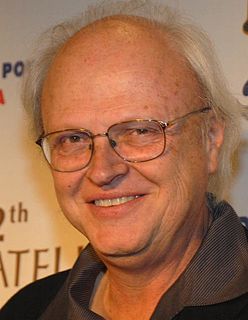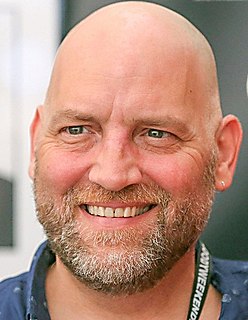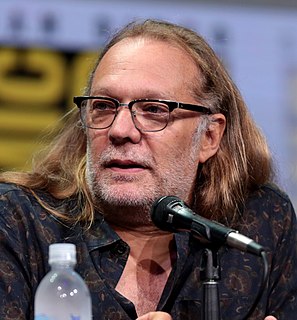
Star Trek III: The Search for Spock is a 1984 American science fiction film, written and produced by Harve Bennett, directed by Leonard Nimoy, and based on the television series Star Trek. It is the third film in the Star Trek franchise, and is the second part of a three-film story arc that begins with Star Trek II: The Wrath of Khan (1982) and concludes with Star Trek IV: The Voyage Home (1986). After the death of Spock (Nimoy), the crew of the USS Enterprise returns to Earth. When James T. Kirk learns that Spock's spirit, or katra, is held in the mind of Dr. Leonard "Bones" McCoy, Kirk and company steal the decommissioned USS Enterprise to return Spock's body to his homeworld. The crew must also contend with hostile Klingons led by Kruge who are bent on stealing the secrets of a powerful terraforming device.

Prosthetic makeup is the process of using prosthetic sculpting, molding and casting techniques to create advanced cosmetic effects. Prosthetic makeup goes back to the beginning of film making with A Trip to the Moon, a 1902 French adventure short film directed by Georges Méliès where the man on the moon effect was accomplished using a combination of makeup and a prosthetic type mask with added pastes. The makeup artist Jack Pierce was another early Hollywood make-up artist, best remembered for creating the iconic makeup worn by Boris Karloff in Frankenstein, his makeup for the Wolfman, and more. Modern prosthetic makeup was revolutionized by John Chambers, whose work can be seen in Planet of the Apes, as well as Dick Smith's work in Little Big Man, Stan Winston in the Terminator series, and Rob Bottin in The Thing.

Animatronics refers to mechatronic puppets. They are a modern variant of the automaton and are often used for the portrayal of characters in films and in theme park attractions.

A practical effect is a special effect produced physically, without computer-generated imagery or other post-production techniques. In some contexts, "special effect" is used as a synonym of "practical effect", in contrast to "visual effects" which are created in post-production through photographic manipulation or computer generation.

Stanley Winston was an American television and film special make-up effects creator, best known for his work in the Terminator series, the first three Jurassic Park films, Aliens, The Thing, the first two Predator films, Inspector Gadget, Iron Man, and Edward Scissorhands. He won four Academy Awards for his work.

The Chronicles of Narnia: The Lion, the Witch and the Wardrobe is a 2005 high fantasy film directed by Andrew Adamson, who co-wrote the screenplay with Ann Peacock, Christopher Markus, and Stephen McFeely, based on the 1950 novel The Lion, the Witch and the Wardrobe, the first published and second chronological novel in the children's book series The Chronicles of Narnia by C. S. Lewis. The film is the first installment in The Chronicles of Narnia film series. It was produced by Walt Disney Pictures and Walden Media, and distributed by Buena Vista Pictures Distribution.

The Chronicles of Narnia: Prince Caspian is a 2008 high fantasy film directed by Andrew Adamson, who co-wrote the screenplay with Christopher Markus and Stephen McFeely, based on the 1951 novel Prince Caspian, the second published and fourth chronological novel in the children's book series The Chronicles of Narnia by C. S. Lewis. The sequel to The Chronicles of Narnia: The Lion, the Witch and the Wardrobe (2005), it is the second installment in The Chronicles of Narnia film series.

Dennis Muren, A.S.C is a self-taught American film visual effects artist and supervisor. He has worked on the films of George Lucas, Steven Spielberg, and James Cameron, among others, and won nine Oscars in total: eight for Best Visual Effects and a Technical Achievement Academy Award. The Visual Effects Society has called him a perpetual student, teacher, innovator, and mentor.
David W. Allen was an American film and television stop motion model (puppet) animator.

Phil Tippett is an American movie director and Oscar and Emmy Award-winning visual effects supervisor and producer, who specializes in creature design, stop-motion and computerized character animation. Over his career, he has assisted ILM and DreamWorks, and in 1984 formed his own company, Tippett Studio.

Robert Kurtzman is an American film director, producer, screenwriter, and special effects makeup artist.

Gregory Nicotero is an American special make-up effects creator, television producer, and director. His first major job in special effects makeup was on the George A. Romero film Day of the Dead (1985), under the tutelage of Romero and make-up effects veteran Tom Savini.

Jim Henson's Creature Shop is a special/visual effects company founded in 1979 by puppeteer Jim Henson, creator of The Muppets. The company is based out of Burbank, California, United States.
Nick Dudman is a British make-up effects and creature designer for motion pictures.
Legacy Effects, LLC is an American special effects studio specializing in creature design, prosthetic makeup, animatronics, and specialty suits.
Dave Elsey is a make-up artist known for special make-up effects, creature effects and animatronics in films such as X-Men: First Class, Ghost Rider, Star Wars, Hellraiser, Alien 3, and Indiana Jones. He was born on February 2, 1967 in London, England to Marie and Derek Elsey. From 1999 to 2011, Elsey lived in Sydney, Australia with his wife Lou while working on the TV science fiction series Farscape. He currently resides in Los Angeles, California.
Shaun Smith is an American special make-up effects supervisor and prop creator from Rockford, Illinois. His work portfolio includes major theatrical releases such as 300, Face/Off, Conan the Barbarian, I Am Legend, The Monkey King 3, Dawn of the Dead, Starship Troopers, and Chronicles of Narnia.

Creature suits are realistic costumes used to disguise a performer as an animal, monster, or other being. They are used in film, television, or as costumed characters in live events. Unlike mascots, they are often made with a high degree of realism. In contrast with prosthetic makeup, which is applied to an actor's skin, the wearer is not normally visible outside their movements controlling the costume, although in some cases, part of the wearer's body is still visible.
KNB EFX Group is an American special effects company that specializes in prosthetic makeup, animatronics, and other practical effects. It was founded in 1988 by Robert Kurtzman, Greg Nicotero, and Howard Berger, though Kurtzman left in 2003. After establishing a reputation for gory effects in horror films throughout the late 1980s and early 1990s, they broadened to performing animatronics and makeup effects for mainstream comedy and drama films. Their work on The Chronicles of Narnia: The Lion, the Witch and the Wardrobe and The Walking Dead have netted them multiple awards and nominations.

Jurassic Park, later known as Jurassic World, is an American science fiction adventure media franchise. It focuses on the cloning of dinosaurs through ancient DNA, extracted from mosquitoes that have been fossilized in amber. The franchise explores the ethics of cloning and genetic engineering, and the morals behind de-extinction.















